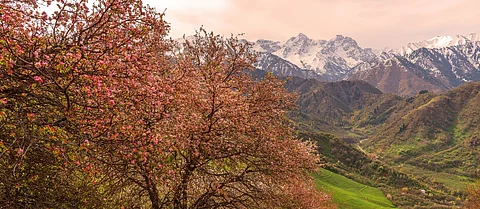
- Destinations
- Experiences
- Stay
- What's new
- Celebrating People
- Responsible Tourism
- CampaignsCampaigns
- SubscribeSubscribe
- Buy Now

When you bite into a large, sweet apple from the neighbourhood grocery store, it's easy to take the qualities of our modern fruits for granted. We hardly consider the long history of both random and deliberate migration and modification that produced the seemingly flawless apples we enjoy today.
Were the apples of our past always so tasty? How much have apples changed, and where did they come from? In the heart of Central Asia, nestled among Kazakhstan's majestic Tian Shan mountains, lies one of nature's most remarkable treasures: the last remaining wild apples of the world—the Malus sieversii. The journey to uncover the origins of the apple takes us to Almaty, Kazakhstan's vibrant capital, whose very name, derived from the Kazakh word Almatau for "apple mountain," hints at the city's deep-rooted connection to these fruits.
The apple genome was initially discovered in a grove near Almaty, a small town whose wild apples are almost identical to the Golden Delicious apples sold in grocery stores today. This discovery was made by biologist Nikolai Vavilov at the beginning of the 20th century. When Vavilov travelled to Almaty, he was astounded to see apple trees growing wildly, unkempt, and unevenly spaced—a phenomenon he had never seen anywhere in the world.
Scientists believe birds and bears carried the seeds out of Kazakhstan long before humans cultivated Tian Shan apples. By the time humans started cultivating and trading apples, Malus sieversii had already taken root in Syria. It was there that the Romans discovered it and spread the fruit even farther across the globe. When state-of-the-art genome sequencing projects affirmatively connected domestic apples to Malus sieversii, Almaty and the surrounding area were officially recognised as the origin of all apples.
Today, the wild apple forests of Kazakhstan are recognised as a living museum of genetic diversity, protected within the confines of reserves scattered across the Tian Shan mountain range. Yet, the true guardians of these forests might well be the local wildlife, such as bears, who feast on the apples with no regard for their botanical pedigree. Pomologists report that the flavours of wild apples vary depending on how the bees pollinate the blossoms. There are apples with berry and honey flavours, tart crabapples, liquorice-flavoured apples, and a few varieties suitable for a supermarket's produce section.
As we enjoy the fruits of modern agriculture, let us not forget the wild orchards of the Tian Shan mountains, where the story of the apple began. Here, in these ancient groves, the past, present, and future of one of the world's most iconic fruits intertwine, reminding us of the delicate balance between nature and human progress.
These days, apple forests only exist in patches around the Tian Shan mountain range. The Ile-Alatau National Park has various protected areas; however, it is recommended that you hire a guide to show you around since they are difficult to find.
The Almaty International Airport in Almaty, Kazakhstan, is the largest in the country and boasts direct connectivity from Delhi. The direct flight lasts up to 6 hours and 40 minutes. Suppose you are flying in from other Indian cities like Mumbai and Bengaluru. In that case, there's likely to be a layover in Dubai, Doha or even Delhi, depending on the airline you choose.
